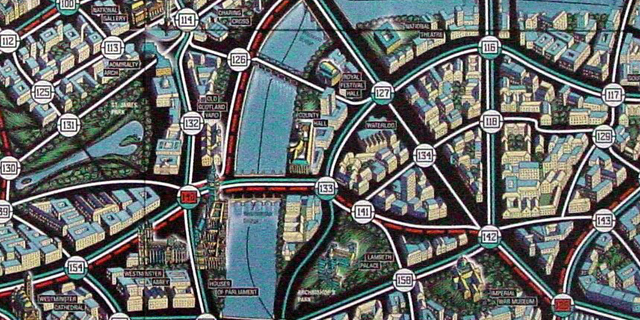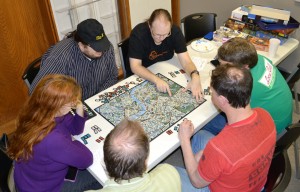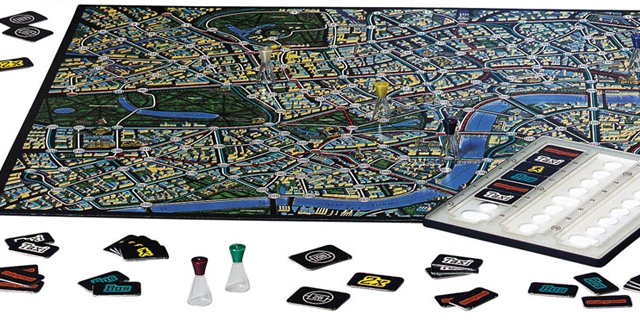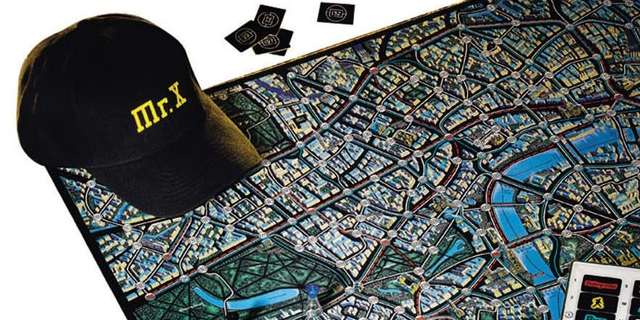
In previous columns I have discussed Fury of Dracula and Letters from Whitechapel (reprint from Fantasy Flight coming Q2 2013!), two games featuring one player making hidden movements while everybody else tries to track them down via various clues they discover along the way. This time, I’m digging all the way back to 1983 and one of the originators of the hidden-movement mechanic, Scotland Yard (most recently published in the US by Ravensburger). Yes, 1983. My version is the twentieth anniversary edition that was just re-released in time for its thirtieth anniversary, and the gameplay is still as solid now as I’m sure it was revolutionary thirty years ago.
As mentioned, one player takes on the mantle of Mr. X, and even gets a snazzy – if somewhat small – embroidered black baseball cap to illustrate this. See if you can figure out who is Mr. X in this game being played at my weekly board game night’s sixth anniversary party:
 (Image provided by GamerChris.com)
(Image provided by GamerChris.com)Mr. X also gets a board for keeping track of his secret movement, a selection of movement tickets, two “2X” move tokens and a number of “dark” move tickets equal to the number of detectives chasing him (usually the number of other players, although fewer players might require the use of multiple detectives per player). Each other player receives a colored pawn, ten taxi tickets, eight bus tickets and four underground tickets. To begin, each player receives a random starting location token and places their pawns there, although obviously Mr. X keeps his location secret.

Movement on the board is achieved by using one of your various tickets to move along the corresponding route to the next available location of that type. Mr. X marks down the number of his new location and then hides it by laying the movement ticket he used on top of it. Each numbered space on the board has at least one taxi route connecting it to other spaces, while bus routes connect fewer and underground stations are limited to only a handful of locations.
Detectives only have their starting assortment of tickets and cannot get more, so they have to plan their movements carefully, especially towards the endgame. Mr. X, on the other hand, has no such restrictions and in fact has a couple of extra tricks up his sleeve in the form of his “dark” tickets. Using one of these both completely obscures his mode of travel that turn as well as allowing him to use one of the three river travel routes should he be in one of the correct locations. Should he feel the need to put some distance between himself and the detectives, Mr. X can also spend one of his “2X” tokens to make two movements in a row, although he cannot move through a space occupied by a detective in this way.
The first few moves of the game are mostly for positioning, as the detectives have no clue where Mr. X could be. After his third move, however, Mr. X appears on the board (using a designated pawn). He will disappear again on his next turn, but now at least the detectives have some direction, and more importantly they will be able to narrow down options for possible paths of escape as long as Mr. X doesn’t rely on a dark move to vanish. Mr. X will reappear periodically throughout the remainder of the game, as indicated by the larger windows on his movement board. Assuming Mr. X is cunning enough to not make any careless mistakes, the detectives will have to rely on these sporadic sightings to inform their movement choices. These appearances happen even if Mr. X has double-moved through that specific window.

Obviously the detectives win if one of them should move on to the space containing Mr. X. As each detective only has 22 movement tickets, Mr. X must usually elude them for that many turns in order to win. However, since they are also restricted as to the types of tickets they have at their disposal, Mr. X can also claim victory if no detective can move legally. Generally this will only happen once a detective has exhausted their supply of taxi tickets.
What makes Scotland Yard such a great experience is how streamlined the play is. The game will never last more than 22 turns by design, rarely longer than an hour of real-time play, and unlike its descendants there is nothing interfering with the cat-and-mouse chase. There are none of the various card-based complications of Fury of Dracula, and no periodic resetting of the chase as in Letters from Whitechapel. There’s just a number of brains working against one within the limitations provided, in the best illustration of what makes gaming so fun. While Fury and Whitechapel both have their own charms, Scotland Yard serves as a great introduction to the genre due to its simplicity and quick play.
Scotland Yard retails for about $40.



















